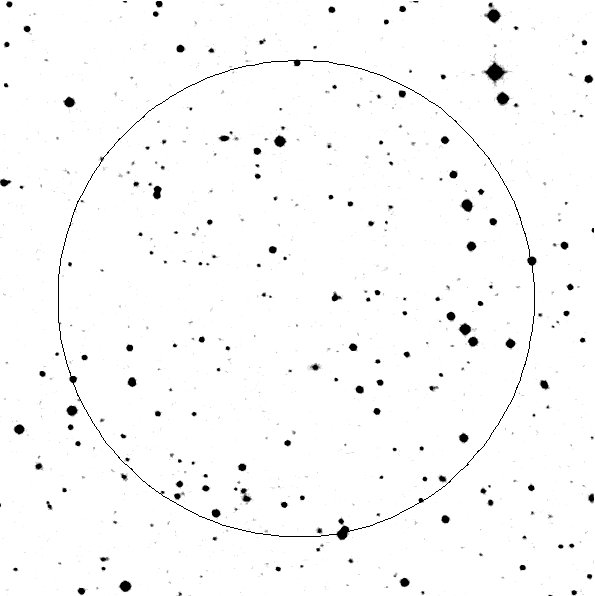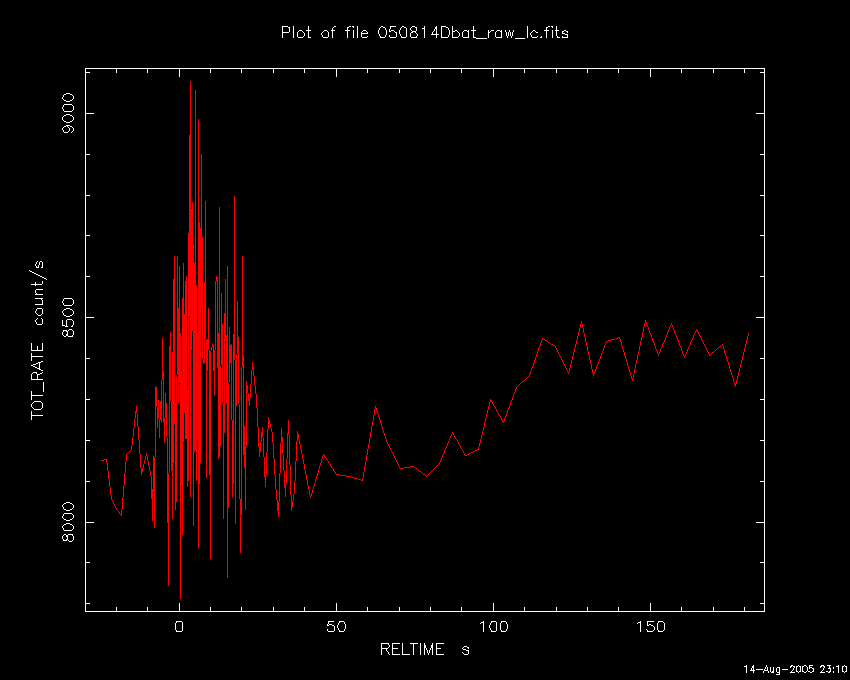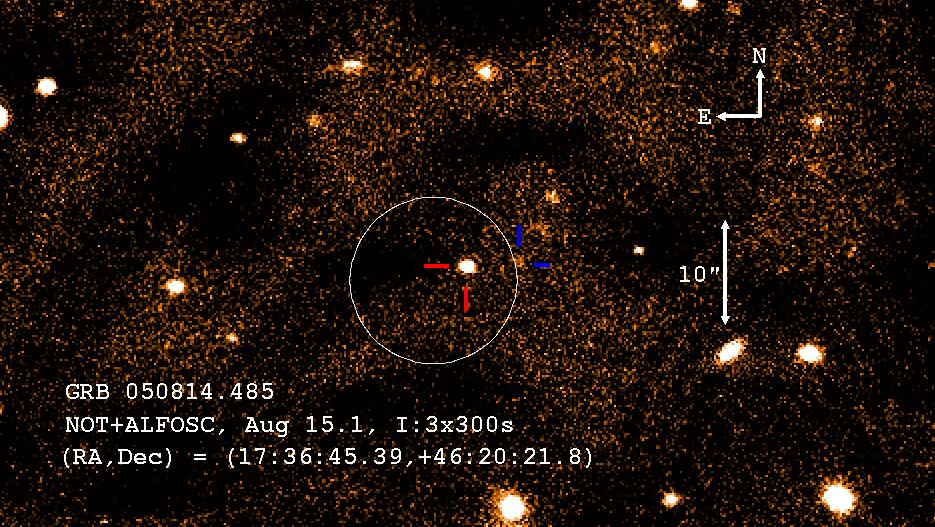- GCN/BACODINE POSITION NOTICE
TITLE: GCN/SWIFT NOTICE
NOTICE_DATE: Sun 14 Aug 05 11:41:45 UT
NOTICE_TYPE: Swift-XRT Nack-Position
TRIGGER_NUM: 150314, Seg_Num: 0
POINT_RA: 264.203d {+17h 36m 49s} (J2000)
POINT_DEC: +46.332d {+46d 19' 56"} (J2000)
GRB_DATE: 13596 TJD; 226 DOY; 05/08/14
GRB_TIME: 42075.03 SOD {11:41:15.03} UT
COUNTS: 195 Min_needed= 20
STD_DEV: 0.00 Max_StdDev_for_Good=28.44 [arcsec]
PH2_ITER: 4 Max_iter_allowed= 4
ERROR_CODE: 2
COMMENTS: SWIFT-XRT Nack Position.
COMMENTS: Algorithm did not converge; too many interations.
- red DSS finding chart
ps-file

- GCN/BACODINE POSITION NOTICE
TITLE: GCN/SWIFT NOTICE
NOTICE_DATE: Sun 14 Aug 05 11:43:05 UT
NOTICE_TYPE: Swift-BAT GRB Lightcurve
TRIGGER_NUM: 150314, Seg_Num: 0
GRB_RA: 264.204d {+17h 36m 49s} (J2000),
264.243d {+17h 36m 58s} (current),
263.854d {+17h 35m 25s} (1950)
GRB_DEC: +46.333d {+46d 19' 58"} (J2000),
+46.330d {+46d 19' 46"} (current),
+46.362d {+46d 21' 42"} (1950)
GRB_DATE: 13596 TJD; 226 DOY; 05/08/14
GRB_TIME: 41936.96 SOD {11:38:56.96} UT
TRIGGER_INDEX: 459
GRB_PHI: 36.87 [deg]
GRB_THETA: 39.66 [deg]
DELTA_TIME: 65472.00 [sec]
TRIGGER_DUR: 16.384 [sec]
LC_URL: sw00150314000msb.lc
SUN_POSTN: 144.16d {+09h 36m 37s} +14.24d {+14d 14' 42"}
SUN_DIST: 99.06 [deg]
MOON_POSTN: 246.57d {+16h 26m 17s} -25.98d {-25d 59' 05"}
MOON_DIST: 74.07 [deg]
MOON_ILLUM: 65 [%]
GAL_COORDS: 72.63, 31.76 [deg] galactic lon,lat of the pointing direction
ECL_COORDS: 258.49, 69.54 [deg] ecliptic lon,lat of the pointing direction
COMMENTS: SWIFT-BAT GRB Lightcurve.
COMMENTS:
COMMENTS: The next comments were copied from the BAT_POS Notice:
COMMENTS: This is a rate trigger.
COMMENTS: A point_source was found.
COMMENTS: This does not match any source in the on-board catalog.
COMMENTS: This does not match any source in the ground catalog.
COMMENTS: This is a GRB.
COMMENTS: Since the IMAGE_SIGNIF is less than 7 sigma, this is a questionable detection.

- GCN notice #3799
A. Retter (PSU), L. Barbier (GSFC), S. Barthelmy (GSFC), A. Blustin
(UCL-MSSL), D. Burrows (PSU), C. Markwardt (GSFC/UMD), F. Marshall (GSFC),
D. Morris (PSU), D. Palmer (LANL), J. Racusin (PSU), P. Roming (PSU), and
N. Gehrels (GSFC) report on behalf of the Swift team:
At 11:38:57 UT, Swift-BAT triggered and located GRB050814
(trigger=150314). The BAT on-board calculated location is
RA,Dec 264.204,+46.333, {+17h 36m 49s, +46d 19' 58"} (J2000),
with an uncertainty of 3 arcmin (radius, 90% containment,
stat+sys). There is a single peak with an approximate
duration of 25 sec FWHM. The peak rate is approx 800 ct/s in the
15-350 keV band. We note that no BAT Position Notice was
distributed through the GCN for this burst.
The S/C slewed immediately and the XRT began taking data at 11:41:15, 138 s
after the BAT trigger. The XRT on-board centroid algorithm did not
converge and no prompt position is available. However, the lightcurve
shows a bright, decaying source in the field of view, and the spectrum
looks like a GRB. We are waiting for down-linked data to determine a position.
The UVOT began observing at 11:41:43.9 UT, 167 s after the BAT trigger. In
a 100 s V-band image, no new source is detected with respect to the DSS
image down to a 5 sigma upper limit of 18.0 mag.
- GCN notice #3800
D. C. Morris, D. N. Burrows, J. A. Kennea, J. L. Racusin (PSU), and N.
Gehrels (GSFC) report on behalf of the Swift XRT team:
The Swift BAT instrument detected GRB 050814 at 11:38:57 UT (Retter et al.
2005, GCN 3799). The observatory executed an automated slew to the BAT
position and the XRT began taking data at 11:41:15 UT (138 seconds after
the BAT trigger). In spite of the presence of a bright source in the
field, the XRT did not succeed in calculating an on-board centroid,
probably because of a high background level. In the ground-processed data,
we find a bright, uncataloged, rapidly fading X-ray source located at:
RA(J2000) = 17:36:45,
Dec(J2000) = +46:20:19.
We identify this as the afterglow of the GRB. We estimate an uncertainty
of about 7 arcseconds radius (90% containment). This source is located 44
arcseconds from the BAT position in GCN 3799.
- GCN notice #3803
J. Tueller (GSFC), C. Markwardt (GSFC/UMD), L. Barbier (GSFC),
S. Barthelmy (GSFC), J. Cummings (GSFC/NRC), E. Fenimore (LANL),
N. Gehrels (GSFC), D. Hinshaw (GSFC-SPSYS), D. Hullinger (GSFC/UMD),
H. Krimm (GSFC/USRA), P. Meszaros (PSU), D. Palmer (LANL), A. Parsons (GSFC),
T. Sakamoto (GSFC/NRC)
on behalf of the Swift-BAT team:
Using the full data set from the recent telemetry downlink, we report
further analysis of Swift-BAT GRB 050814 (trigger #150314)
(Retter, et al., GCN 3799). The ground-analysis position is
RA,Dec 264.189,+46.354 (J2000) with an uncertainty of 3 arcmin
(radius, 90%, stat+sys). The light curve shows a gradual increase
in emission starting at T-15 sec with a peak at ~T+5 sec
and then a longer gradual decline out to ~T+120 sec.
T90 is 65 +40/-20 sec. Fitting a simple power law over
the interval from T-1 to T+67 sec, the photon index is
1.80 +/- 0.17 with a fluence of 2.17 +/- 0.36 X 10^-6 erg/cm^2
in the 15-350 keV band (90% c.l.). The peak flux in a 1-sec wide window
starting at T+4.2 seconds is 1.0 +/- 0.3 ph/cm^2/sec (15-350 keV).
- GCN notice #3804
A. J. Blustin (UCL-MSSL), A. Retter (PSU), F. Marshall (GSFC),
M. Chester (PSU), N. Gehrels (GSFC) on behalf of the Swift/UVOT
team
Swift/UVOT began observing the field of GRB050814 at 11:41:44 UT,
167 s after the BAT trigger (Retter et al., GCN 3799). We detect no
new source with respect to the DSS image within the XRT error circle
(Morris et al., GCN 3800) in summed images from any filter
down to the following 3-sigma magnitude upper limits:
Filter T_range Exp (s) 3-sig UL (mag)
V 167-13371 1375 20.5
B 313-8353 1046 21.4
U 299-7587 1187 21.2
UVW1 285-6680 1194 20.3
UVM2 271-14137 1144 20.7
UVW2 328-12464 1277 20.8
Where T_range is the time range of the summed images in seconds
post-trigger.
These magnitudes are based on preliminary zero-points, measured in
orbit, and will require refinement with further calibration.
- GCN notice #3805
D. C. Morris, D. N. Burrows, J. A. Kennea, J. L. Racusin (PSU), and N.=20
Gehrels (GSFC) report on behalf of the Swift XRT team:
We have analysed the first five orbits of data for GRB050814 (GCN 3799,=20
Retter et al., 2005). Using xrtcentoid, the refined position is:
RA(J2000) =3D 17h 36m 45.7s
Dec(J2000) =3D +46d 20' 20.5"
with an uncertainty of 8 arcsec. This is 5.4 arcsec from the original=20
XRT position (GCN 3800, Morris et al., 2005). The initially distributed=20
XRT position was based on the first orbit of PC data and may have been=20
effected by a hot column at the position of the source. The refined=20
position is calculated by analyzing several orbits of PC data, each=20
taken at slightly different positions on the detector, so that the hot=20
column in the first orbit of data is no longer a problem for the=20
centroiding algorithm.
The XRT began taking data at 11:41:15UT, 138 seconds after the BAT=20
trigger. Both the windowed timing and photon counting data from the=20
first orbit show a fading lightcurve consistent with a decay index of=20
~4. Photon counting data from subsequent orbits shows a flattening of=20
the lightcurve near T+1000s to a decay index of ~0.1.
The windowed timing spectrum (data from +165s to +383 after the BAT=20
trigger) is well fit (reduced chi-sq of 1.22 for 72 dof) by a power law=20
with neutral hydrogen somewhat larger than the galactic column density=20
of 2.57e20:
gamma=3D2.1 =B1 0.1
NH=3D6.94e20 =B1 2e18
The photon counting spectrum (from +383s through orbit 5) is well fit=20
(reduced chi-sq of 0.61 for 31 dof) by a power law also with excess=20
absorption:
gamma=3D1.8 =B1 0.2
NH=3D7.82e20 =B1 7e18
The count rate at 20000s after the trigger is ~0.15 cts/s which converts=20
to an unabsorbed flux of 4.76e-12 ergs cm^-2 s^-1.
It should be noted that the early versions of the SDC data contained=20
processing errors, likely due to earthlimb contamination, which may yet=20
be contributing to some peculiarities in the PC lightcurve.
- GCN notice #3807
S. Bradley Cenko (Caltech) reports on behalf of a larger collaboration:
We have imaged the field of GRB050814 (Swift 150314, Retter et al., GCN
3799) with the automated Palomar 60-inch telescope. Observations
consisted of 18 x 120 s images in both the Kron R and Gunn i filters,
and were taken at a mean epoch of 15 August 04:43 UT (~ 17.1 hours after
the burst).
In the revised XRT error circle (Morris et al, GCN 3805), we find a
faint source marginally detected (~2 sigma) in our i-band coadd. This
source is not present in any of the Second Generation Digital Sky Survey
plates, although it is likely below the detection threshold. The
coordinates (J2000) of the source are
RA: 17:36:45.39
Dec: +46:20:21.6
with an estimated uncertainty of ~0.2" in each direction.
By comparison with the USNO-B1 star located at 17:36:50.9, +42:20:45.0
(USNO 1363-0276928, I = 15.73), we estimate the magnitude of this source
is i ~ 21.4 +/- 0.3. Given its faintness, we cannot determine whether
the source is variable, and therefore cannot confirm whether it is the
afterglow of GRB050814.
We find no sources present in the XRT error circle in our R-band coadd
to a (3-sigma) limiting magnitude of R > 21.3.
Further observations and analysis are planned.
- GCN notice #3809
Brian L. Jensen, Johan P. U. Fynbo, Jens Hjorth, Jesper Sollerman,
Jos=E9 Mar=EDa Castro Cer=F3n, Kristian Pedersen, P=E1ll Jakobsson,
Darach Watson (DARK, NBI), Jan-Erik Solheim (U. of Olso, Norway)
report:
"Using ALFOSC on the Nordic Optical Telescope we have obtained VRI
imaging of the field of GRB 050814.485 (Retter et al., GCN#3799)
on August 15.1, 2005 UT (~13.5 h after the burst).
In the refined XRT error-circle (Morris et al., GCN#3805) we clearly
detect the source reported by Bradly Cenko (GCN#3807) in our I- and
R-band images, whereas the source is absent in the V-band.
Based on preliminary photometry, we obtain for the source :
Date (UT) Filter Exptime Seeing Mag
Aug 15.04 V 3x300s 1.1" >23.0
Aug 15.06 R 3x300s 1.0" 23.2
Aug 15.07 I 3x300s 0.9" 20.5
Compared to the preliminary I-band detection reported in GCN#3807, the
source appears to be fading.
The colours of the object, if it is the afterglow of GRB 050814.485,
indicate either a high redshift (4.5
In addition, we detect a fainter, bluer source on the edge of the XRT
error-circle (at (RA,Dec)(J2000.0) =3D 17:36:44.93, +46:20:22.33).
An image of the field is shown at:
http://www.astro.ku.dk/~brian_j/grb/grb050814.485/ "

- GCN notice #3818
P=E1ll Jakobsson, Johan P. U. Fynbo, Jens Hjorth, Brian L. Jensen,
Jos=E9 Mar=EDa Castro Cer=F3n, Kristian Pedersen, Jesper Sollerman (DARK,
NBI),
Kalle Torstensson, Karianne Holhjem (NOT, La Palma) and Jan-Erik Solheim
(U. of Oslo, Norway) report:
We have continued monitoring the field of GRB 050814.485 in the I band
using
ALFOSC on the 2.56-meter Nordic Optical Telescope. Compared to our previous
epoch (Jensen et al. GCN#3809) the proposed afterglow appears to be fading.
By comparison with 5 standard stars in SA92 (Landolt, 1992, AJ, 104, 340)
we estimate the following magnitude for the afterglow:
Date (UT) Filter Exptime Seeing Mag
Aug 15.96 I 3x300s 0.8" 21.4
Using I = 20.5 from GCN#3809, the preliminary decay slope is alpha = 0.95.
- GCN notice #3821
P. B. Cameron (Caltech) and D. A. Frail (NRAO) report on behalf of a
larger collaboration:
"We have undertaken VLA observations at a frequency of 8.46 GHz toward
GRB 050814 (GCN 3803) on August 17.03 UT. No radio afterglow is
detected. At the position of the optical afterglow (GCN 3807) the
point-source limit is 73 +/- 36 microJy. No further observations are
planned.
The National Radio Astronomy Observatory is a facility of the National
Science Foundation operated under cooperative agreement by Associated
Universities, Inc.
- astro-ph/0602071 from 3 Feb 2006
Jakobsson: GRB 050814 at z = 5.3 and the Redshift Distribution of Swift GRBs
We report optical, near-infrared and X-ray observations of the afterglow of
GRB 050814, which was seen to exhibit very red optical colours. By modelling
its spectral energy distribution we find that z = 5.3 +/- 0.3. We next present
a carefully selected sample of 19 Swift GRBs, intended to estimate in an
unbiased way the GRB redshift distribution, including the mean redshift
(z_mean) as well as constraints on the fraction of high-redshift bursts. We
find that z_mean = 2.7 and that at least 5% of the GRBs originate at z > 5. The
redshift distribution of the sample is qualitatively consistent with models
where the GRB rate is proportional to the star formation rate in the Universe.
The high mean redshift of this GRB sample and the wide redshift range clearly
demonstrates the suitability of GRBs as efficient probes of galaxies and the
intergalactic medium over a significant fraction of the history of the
Universe.
- A&A 490, 1047 from 11/2008: photo-z=5.77+-0.12
Curran et al: Robust photometric redshift determinations of gamma-ray burst afterglows at z >= 2
Context: Theory suggests that about 10% of Swift-detected gamma-ray bursts (GRBs) will originate at redshifts, z, greater than 5 yet a number of high redshift candidates may be left unconfirmed due to the lack of measured redshifts.
Aims: Here we introduce our code, GRBz, a method of simultaneous multi-parameter fitting of GRB afterglow optical and near infrared, spectral energy distributions. It allows for early determinations of the photometric redshift, spectral index and host extinction to be made.
Methods: We assume that GRB afterglow spectra are well represented by a power-law decay and model the effects of absorption due to the Lyman forest and host extinction. We use a genetic algorithm-based routine to simultaneously fit the parameters of interest, and a Monte Carlo error analysis.
Results: We use GRBs of previously determined spectroscopic redshifts to prove our method, while also introducing new near infrared data of GRB 990510 which further constrains the value of the host extinction.
Conclusions: Our method is effective in estimating the photometric redshift of GRBs, relatively unbiased by assumptions of the afterglow spectral index or the host galaxy extinction. Monte Carlo error analysis is required as the method of error estimate based on the optimum population of the genetic algorithm underestimates errors significantly.
- 1505.03024 from 13 May 15
L. Zaninetti: Relativistic scaling laws for the light curve in supernovae
In order to explain light curve (LC) for Supernova (SN) we derive a classical formula for the conversion of the flux of kinetic energy into
radiation. We then introduce a correction for the absorption adopting an optical depth as function of the time. The developed framework allows
to fit the LC of type Ia SN 2005cf ( B and V ) and type IIp SN 2004A (B,V,I and R ). A relativistic formula for the flux of kinetic energy is
also derived in terms of a Taylor expansion and the application is done to the LC of GRB 050814. The decay of the radioactive isotopes as a
driver the LC for SNs is also reviewed and a new formulation is introduced. The Arnett's formula for bolometric luminosity is corrected for the
optical depth and applied to SN 2001ay.
![]() Previous IAU Circulars
Previous IAU Circulars 

